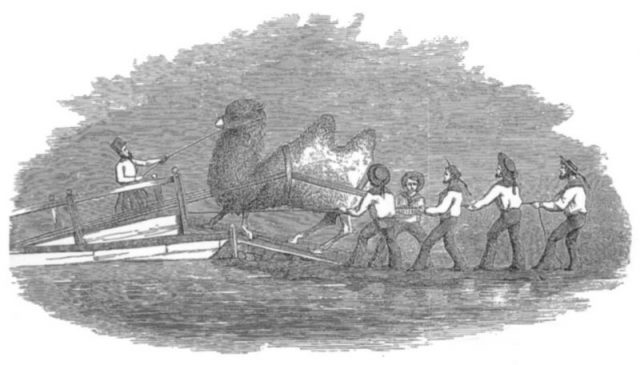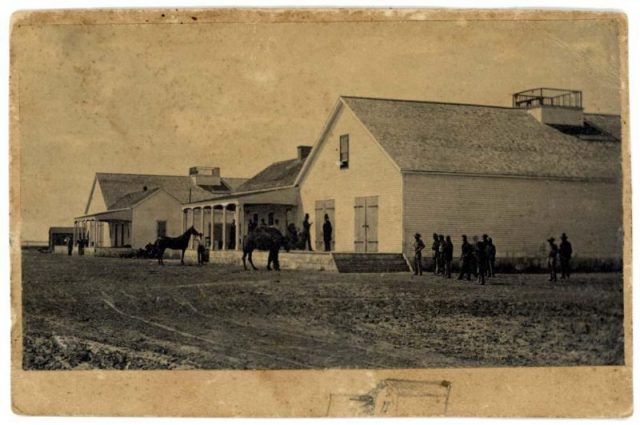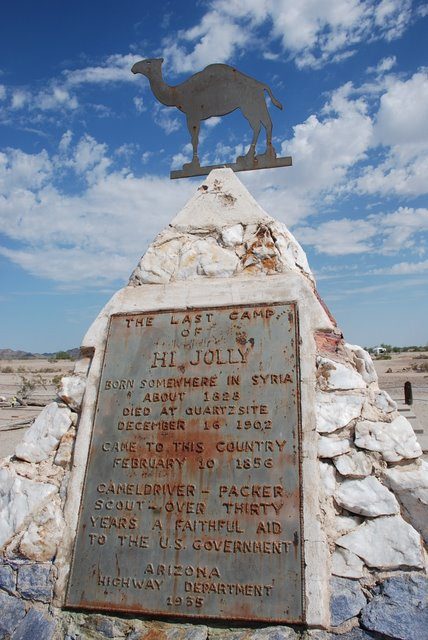A folk tale from the Old West has it that in the 1880s, the Arizona territory was haunted by a menacing creature known as the Red Ghost. The red-eyed creature was said to be 30 feet tall, had trampled a woman to death, and charged a man who tried to capture it.
“Eyewitnesses said it was a devilish looking creature strapped on the back of some strange-looking beast,” Marshall Trimble, Arizona’s official state historian, told Smithsonian magazine in 2015. Years later, a rancher shot a camel grazing in his garden. On the dead camel’s back, the rancher found rawhide straps, evidence of a past rider. The Red Ghost was dead. But wait a second. A wild camel? In Arizona?
The American imperative of Manifest Destiny bumped up against a serious obstacle in the Southwest in the mid 1800s, namely the terrain. Arid deserts, craggy mountains, and the thin air of altitude proved difficult for man and beast alike. An undeterred Army lieutenant studied the problem and sent a report to Washington with an ingenious solution: camels.
The camel proposal caught the eye of Mississippi Senator Jefferson Davis, fresh off the Mexican-American war, who vigorously pushed the idea, even as he became Secretary of War. It took a few years, but on March 3, 1855, Congress appropriated $30,000 “to be expended under the direction of the War Department in the purchase and importation of camels and dromedaries to be employed for military purposes.” The U.S. Camel Corps was born.

“For strength in carrying burdens, for patient endurance of labor, and privation of food, water & rest, and in some respects speed also, the camel and dromedary (as the Arabian camel is called) are unrivaled among animals,” Army Lieutenant George H. Crosman wrote in his report. “The ordinary loads for camels are from seven to nine hundred pounds each, and with these they can travel from thirty to forty miles a day, for many days in succession. They will go without water, and with but little food, for six or eight days, or it is said even longer. Their feet are alike well suited for traversing grassy or sandy plains, or rough, rocky hills and paths, and they require no shoeing.”

One small problem: There were no camels in the United States. So Major Henry C. Wayne, another camel enthusiast, was deployed to the Mediterranean to obtain the beasts, travels that took him to Malta, Greece, Turkey, and Egypt, where he managed to obtain a total of 33 camels for $250 each. The camels were loaded aboard the aptly named Navy store ship USS Supply for their voyage to Texas which, thanks to horrendous weather and heavy gales, took three months.

Author “Jeremy Butler CC BY-SA 3.0
The camels arrived mostly healthy and unharmed, and after giving them a couple of weeks to acclimatize, Wayne marched them inland to Camp Verde, near San Antonio, Texas, where he established a caravansary. Six months later, another load of camels arrived, bringing the total to 70.
Over the next few months, Wayne trained soldiers and civilians in the fine art of camel handling: how to feed the beasts, pack loads they could handle, put on their odd saddles, and most importantly, treat them with respect. Camels are mostly docile animals but famously ill-tempered if they are mistreated. They will spit large wads, bite, and kick abusers. Also, they stink, and their unusual smell frightened the horses.
In 1857, Wayne was transferred back to D.C. That same year, Congress awarded a contract to Lieutenant Edward F. Beale to survey a route from Fort Defiance, New Mexico, to eastern California along a trail that would one day become Route 66. With one stipulation: Beale had to use 25 of the camels.

Author:Larry D. Moore CC BY-SA 4.0
Beale protested at first, but by the second week of the expedition, the camels had proven their worth, carrying up to 700 pounds and traversing terrains that caused the horses to balk. They ate scrub and prickly cactus along the way, they could go eight to ten days without water, and they weren’t the least bit bothered by the dry heat of the day and plunging cold at night. When the expedition got lost in an impassable canyon and the lack of water made the mules frantic, a small scouting party atop camels found a river, literally saving lives. They made the 1,200-mile journey to California in four months.
“Certainly there never was anything so patient or enduring and so little troublesome as this noble animal,” Beale wrote, according to the U.S. Army Historical Foundation. “They pack their heavy load of corn, of which they never taste a grain; put up with any food offered them without complaint, and are always up with the wagons, and, withal, so perfectly docile and quiet that they are the admiration of the whole camp. ….(A)t this time there is not a man in camp who is not delighted with them.”

Beale completed another survey with the camels in 1858, this one from Fort Smith, Arkansas, to the Colorado River for use as a wagon road and stage line, an expedition that took him a year. This was to be the camels’ last successful venture.
The Civil War effectively ended the great camel experiment. Camp Verde came under Confederate control, and the camels were mistreated, abused, and killed. A herd of 37 camels in Los Angeles were sold at auction. At the end of the war, the surviving Verde camels were likewise auctioned off. After a time, their owners tired of the novelty and upkeep, many were set loose. For years, camels roamed the Southwest, where they became a familiar sight until the early 1900s.
While the camel experiment proved a failure, the idea wasn’t unique to the U.S. Australia also landed on the idea of using the animals for exploration, and between 1840 and 1907, as many as 20,000 camels were imported from India. Today Australia has the largest wild population of camels in the world.
